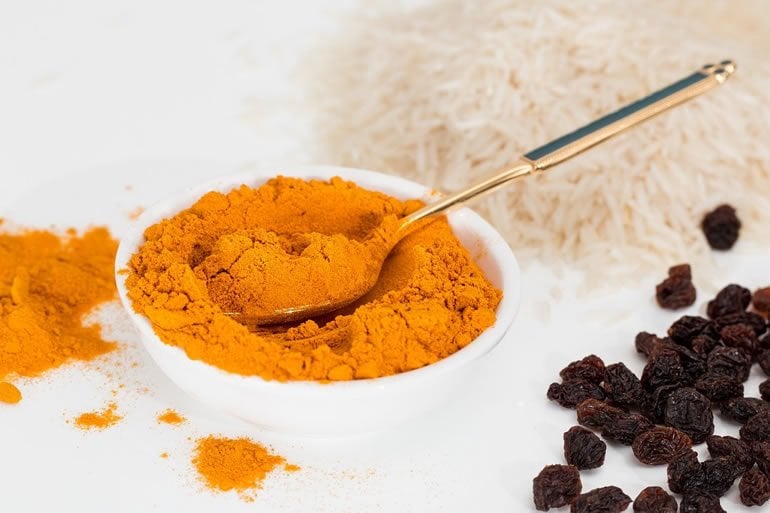Summary: An extract of turmeric is more effective than a placebo at reducing pain in those with knee osteoarthritis. Following 12 weeks of exposure to the extract, people reported less pain than those taking a placebo.
Source: American College of Physicians
An extract of Curcuma longa (CL), commonly known as turmeric, was found to be more effective than placebo for reducing knee pain in patients with knee osteoarthritis. However, CL did not affect structural aspects of knee osteoarthritis, such as swelling or cartilage composition assessed using MRI.
Findings from a randomized, double-blind, placebo-controlled trial are published in Annals of Internal Medicine.
Despite its large disease burden, no approved disease-modifying drugs currently are available to treat osteoarthritis. Common treatments, such as acetaminophen and nonsteroidal anti-inflammatory drugs have only mild to moderate effects and are associated with adverse events. As such, an urgent need exists for safer and more effective drugs to treat osteoarthritis.
Researchers from the University of Tasmania, Australia randomly assigned 70 participants with symptomatic knee osteoarthritis and ultrasound evidence of effusion (swelling inside the knee joint) to receive either 2 capsules per day of CL (n = 36) or matched placebo (n = 34) for 12 weeks to determine the efficacy CL for reducing knee symptoms and joint swelling. Changes in pain and knee effusion-synovitis volume were assessed by standardized questionnaire and MRI, respectively, over 12 weeks.
The researchers also looked for changes in cartilage composition, pain medication usage, quality of life, physical performance measures, and adverse events.

After 12 weeks, they found that patients taking the turmeric supplements reported less pain than those in the placebo group with no adverse events. Besides, participants in the turmeric group consumed fewer pain medications compared to the participants in the placebo group. There was no difference in the structural aspects of knee osteoarthritis between the groups.
Due to the modest effect of the turmeric extracts on knee pain, small sample size of the study, short-duration of follow-up and the single research center, the researchers suggest that multicenter trials with larger sample sizes and long duration of follow-up are needed to assess the clinical significance of their findings.
About this pain research article
Source:
American College of Physicians
Contacts:
Lauren Evans – American College of Physicians
Image Source:
The image is in the public domain.
Original Research: Closed access
“Effectiveness of Curcuma longa Extract for the Treatment of Symptoms and Effusion–Synovitis of Knee Osteoarthritis: A Randomized Trial” by Zhiqiang Wang, MPharm, Graeme Jones, PhD, Tania Winzenberg, PhD, Guoqi Cai, MmedSci, Laura L. Laslett, PhD, Dawn Aitken, PhD, Ingrid Hopper, PhD, Ambrish Singh, MTech, Robert Jones, MD, Jurgen Fripp, PhD, Changhai Ding, PhD, Benny Antony, PhD. Annals of Internal Medicine.
Abstract
Effectiveness of Curcuma longa Extract for the Treatment of Symptoms and Effusion–Synovitis of Knee Osteoarthritis: A Randomized Trial
Background:
Current pharmacologic therapies for patients with osteoarthritis are suboptimal.
Objective:
To determine the efficacy of Curcuma longa extract (CL) for reducing knee symptoms and effusion–synovitis in patients with symptomatic knee osteoarthritis and knee effusion–synovitis.
Design:
Randomized, double-blind, placebo-controlled trial. (Australian New Zealand Clinical Trials Registry: ACTRN12618000080224)
Setting:
Single-center study with patients from southern Tasmania, Australia.
Participants:
70 participants with symptomatic knee osteoarthritis and ultrasonography-defined effusion–synovitis.
Intervention:
2 capsules of CL (n = 36) or matched placebo (n = 34) per day for 12 weeks.
Measurements:
The 2 primary outcomes were changes in knee pain on a visual analogue scale (VAS) and effusion–synovitis volume on magnetic resonance imaging (MRI). The key secondary outcomes were change in Western Ontario and McMaster Universities Osteoarthritis Index (WOMAC) pain and cartilage composition values. Outcomes were assessed over 12 weeks.
Results:
CL improved VAS pain compared with placebo by −9.1 mm (95% CI, −17.8 to −0.4 mm [P = 0.039]) but did not change effusion–synovitis volume (3.2 mL [CI, −0.3 to 6.8 mL]). CL also improved WOMAC knee pain (−47.2 mm [CI, −81.2 to −13.2 mm]; P = 0.006) but not lateral femoral cartilage T2 relaxation time (−0.4 ms [CI, −1.1 to 0.3 ms]). The incidence of adverse events was similar in the CL (n = 14 [39%]) and placebo (n = 18 [53%]) groups (P = 0.16); 2 events in the CL group and 5 in the placebo group may have been treatment related.
Limitation:
Modest sample size and short duration.
Conclusion:
CL was more effective than placebo for knee pain but did not affect knee effusion–synovitis or cartilage composition. Multicenter trials with larger sample sizes are needed to assess the clinical significance of these findings.
Primary Funding Source:
University of Tasmania and Natural Remedies Private Limited.







